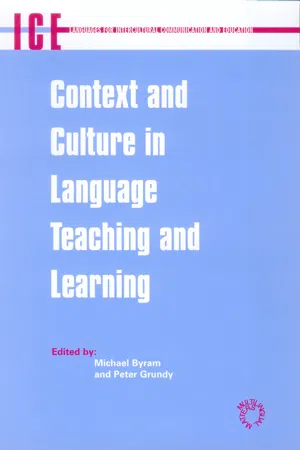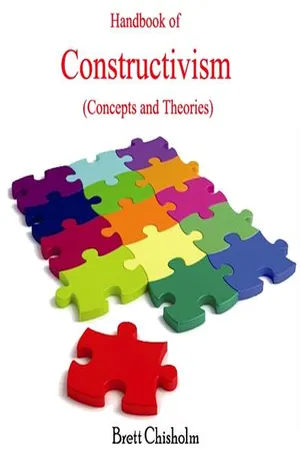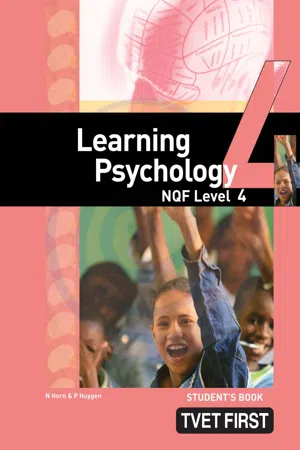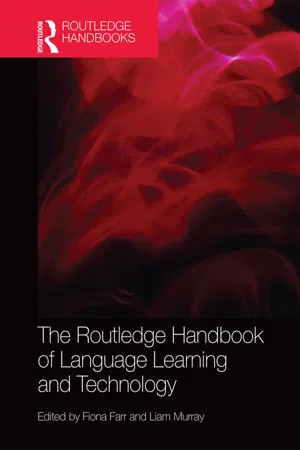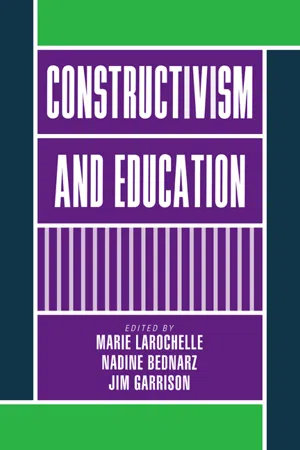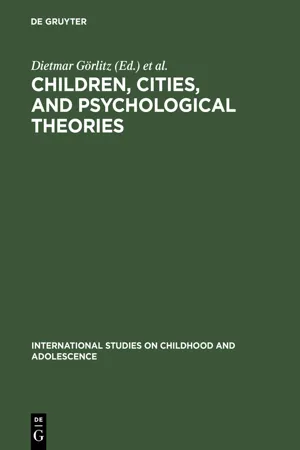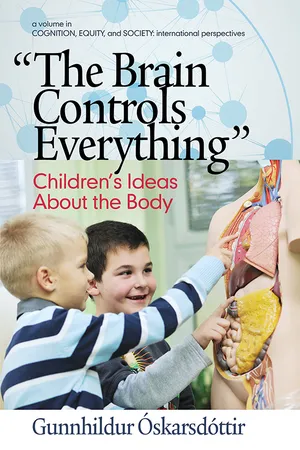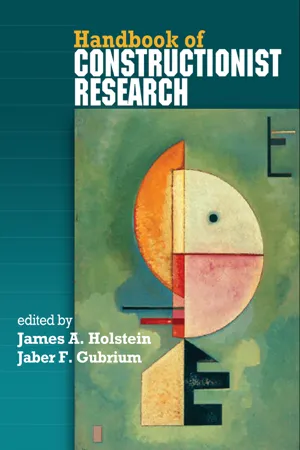Languages & Linguistics
Constructivism
Constructivism is a theory that suggests language and knowledge are constructed by individuals through their experiences and interactions with the world. In linguistics, this perspective emphasizes the role of social and cultural factors in shaping language acquisition and use. It highlights the active role of learners in creating meaning and understanding language.
Written by Perlego with AI-assistance
Related key terms
1 of 5
12 Key excerpts on "Constructivism"
- eBook - PDF
- Beverly Irby, Genevieve H. Brown, Rafael Lara-Aiecio(Authors)
- 2015(Publication Date)
- Information Age Publishing(Publisher)
169 The Handbook of Educational Theories , pp. 169–183 Copyright © 2013 Information Age Publishing, Inc. All rights of reproduction in any form reserved. CHAPTER 15 Constructivism—Constructivist Learning Theory R. NARAYAN, C. RODRIQUES, J. ARAUJO, A. SHAQLAIH, and G. MOSS Ratna Narayan, Cynthia Rodriguez, Juan Araujo, Ali Shaqlaih, and Glenda Moss University of North Texas at Dallas Constructivism is a learning theory that posits that learners actively construct knowledge and make mean-ing, based on their experiences, individually or socially. Confrey (1990, p. 108) describes Constructivism as a belief that all knowledge is necessarily a product of our own cognitive acts. The active role the learner takes in constructivist learning sharply contrasts with one in which learning is the passive transmission of informa-tion from one individual to another (Brooks & Brooks, 1993, Duffy & Cunningham, 1996). Constructivism is a theory that posits knowledge must be constructed by a person, not just transmitted to the person. Two simple but important ideas highlight the notion of constructed knowledge: (a) prior knowledge always influences the formation of new knowledge and (b) learning is an active process (Hoover, 1996). Learners are not blank slates, they bring prior cultural knowledge and/or expe-riences to learning situations that impact the new knowledge they will construct or modify (Merriam & Caffarella, 1999). If the new knowledge emerging is not in agreement with their current schema, the learner can evaluate both and modify their knowledge and schema. Hence meaning making is interpretive and dependent on the learner’s experiences and understanding (Jonas-sen, 1992). People construct knowledge by taking new information and integrating it with their own preexist-ing knowledge (Cooper, 2007; Woolfolk, 2007). - Michael Byram, Peter Grundy, Prof. Michael Byram, Dr. Peter Grundy(Authors)
- 2003(Publication Date)
- Multilingual Matters(Publisher)
Presuming that insightful learning is closely connected to understanding, the author introduces central aspects of epistemological Constructivism, which explains perception as the construction of meaning in educational and cultural contexts. In the fourth part we demonstrate that a number of traditional quantitative and qualitative research methods are not suitable for examining mental processes, contexts and their interdependence. Finally, we recommend the consideration of constructivist principles in research. This way of proceeding requires a disturb-ing change of ideas, which is worthwhile, however, for it helps us to understand language learning and acquisition better. Language Learning Processes and Their Contexts Prior to the triumphal march of the language laboratory in the sixties of the last century, instructional contexts of language learning were basically confined to teacher-centred teaching, language-embedding textbooks and traditional ways of visualisation. They were supplemented by more or less canonical, authorised reading matter, which was to provide access to authentic accounts of the target culture. In the last decades, previously familiar teaching and learning contexts were reorganised to be more flexible, more complex and – in a certain sense – more authentic through other forms of social interaction, of which – in a broader sense – tandem learning is also a part (cf. Bechtl, 2001). The new organisation of 92 Context, Culture and Construction contexts was also achieved through the development of diverse learning envi-ronments, through learning software and the internet. Above all, the opportuni-ties for information and communication provided by the internet can contribute to a globalisation of learning contexts (Müller-Hartmann, 2001: 207ff.). There was, in the same period, a noteworthy development which addressed the requirement for learner orientation and facilitated learning through action.- eBook - PDF
Language-Specific Factors in First Language Acquisition
The Expression of Motion Events in French and German
- Anne-Katharina Harr(Author)
- 2012(Publication Date)
- De Gruyter Mouton(Publisher)
Nonetheless, further (cross-linguistic) evidence is needed to gener- alize these assumptions for all languages or cultures and for the entire lexicon. 3.3 Constructivism Constructivism claims that children learn a language on the basis of construc- tions that they hear in their environment. Prerequisites for language acquisition are different kinds of cognitive abilities (social, general etc.) and positive input (Goldberg 2008a: 15); in other words “humans’ linguistic knowledge is the result of several rather general psychological processes” (Langacker 2000: 57). As pointed out by Goldberg (2008a: 14), “[m]ost construction grammars these days are usage-based”. She then shows how current construction grammars mainly assume that language use plays a crucial role in language learning and process- ing. Since Usage-based theory has its roots in Construction Grammar, we will first present the main assumptions of Construction Grammar, then outline usage- based hypotheses in the domain of first language acquisition, and finally present some criticisms of both theories. 3.3.1 Construction Grammar and usage-based approaches to first language acquisition Traditional Construction Grammar as it was developed by Fillmore and Kay (1985, 1988, 1999) and later on modified by Langacker (1990) claims that certain constructions, especially idiomatic expressions, have meanings that cannot be predicted on the basis of their sub-parts (words, morphemes etc.) and that might therefore be stored as a whole (Evans 2007: 43). Goldberg extended this approach to any kind of construction and showed that constructions have spe- cific meanings on their own (Goldberg 1995: 1). She defines constructions as follows: “[c]onstructions are stored pairings of form and function, including mor- 76 Note that the stronger a verb labels an action linked to just one part of the body, the more salient it is and thus, the more easily it is acquired (cf. Maouene, Hidaka, and Smith 2008: 1207). - No longer available |Learn more
- (Author)
- 2014(Publication Date)
- Learning Press(Publisher)
The importance of the background and culture of the learner Social Constructivism or socioculturalism encourages the learner to arrive at his or her version of the truth, influenced by his or her background, culture or embedded worldview. Historical developments and symbol systems, such as language, logic, and mathematical systems, are inherited by the learner as a member of a particular culture and these are learned throughout the learner's life. This also stresses the importance of the nature of the learner's social interaction with knowledgeable members of the society. Without the social interaction with other more knowledgeable people, it is impossible to acquire social meaning of important symbol systems and learn how to utilize them. Young children develop their thinking abilities by interacting with other children, adults and the physical world. From the social constructivist viewpoint, it is thus important to take into account the background and culture of the learner throughout the learning process, as this background also helps to shape the knowledge and truth that the learner creates, discovers and attains in the learning process (Wertsch 1997). The responsibility for learning Furthermore, it is argued that the responsibility of learning should reside increasingly with the learner (Glasersfeld, 1989). Social Constructivism thus emphasizes the importance of the learner being actively involved in the learning process, unlike previous educational viewpoints where the responsibility rested with the instructor to teach and where the learner played a passive, receptive role. Von Glasersfeld (1989) emphasized that learners construct their own understanding and that they do not simply mirror and reflect what they read. Learners look for meaning and will try to find regularity and order in the events of the world even in the absence of full or complete information. - eBook - PDF
- David Kirk, Doune Macdonald, Mary O′Sullivan, David Kirk, Doune Macdonald, Mary O′Sullivan(Authors)
- 2006(Publication Date)
- SAGE Publications Ltd(Publisher)
Culture plays a major role in how we approach, present, and interpret new knowledge. Both teacher and student bring their own cultural beliefs and expectations to the classroom, both impact children’s success. Constructivism is often used to support the idea that teaching should be child-centered or learner-centered. This does not mean children determine the content and whatever they discover through hands–on activities is acceptable–a misconception about Constructivism. What this means is that teachers focus on what students know, believe, can do, and bring to the classroom and then on how children are understanding, interpreting, thinking and feeling about the content being taught. Being learner-centered means asking, how does this stu-dent understand the content at this moment? What is this child’s level of development and how will that Constructivist perspectives on learning 245 impact her or his response to this task? How is the current classroom environment supporting or not supporting student learning? What content or instructional strategy will best help this child learn? Learning is an active process of constructing knowledge The hallmark of constructivist perspectives from the beginning is that learning is an active process of con-structing knowledge. “The educational philosophy of John Dewey and the developmental psychologists Lev Vygotsky, Jean Piaget, and Jerome Bruner, among others, propose that children actively construct knowledge, and that this knowledge is constructed in a social context” (Zuckerman, 2003: 177). Broadly speaking, cognitive science confirms Piaget’s claim that people must construct their understanding; they do not simply register what the world shows or tells them, as a camera or a tape recorder does. To “know” something, indeed, even simply to memorize effectively, people build a mental representation that imposes order and coherence on experience and information. - eBook - PDF
Learning Psychology NQF4 SB
TVET FIRST
- N Horn P Huygen(Author)
- 2013(Publication Date)
- Macmillan(Publisher)
4 .1 .1 Social Constructivism Social Constructivism is a Socio-cultural Learning Theory. This theory states that individuals construct knowledge by engaging in social activities such as talking about problems or tasks that everyone shares. Individuals are introduced to a culture by more skilled members and this cultural socialising facilitates the individual ’ s learning. When people gather socially, groups collaborate and acquire knowledge from one another. The individual learns about how to be a part of the socio-cultural group through social interaction and guidance from other group members. When you as a teacher apply Social Constructivism in the classroom, learner discussions will provide valuable insight into their different socio-cultural backgrounds. There are many advantages to using discussions in the classroom: Group discussions allow learners to communicate ideas orally and • also provide opportunities for learners to learn from each other. By varying discussions between large and small groups, learners • are able to exercise self-regulation, self-determination, and a desire to persevere with tasks. Group discussion increases a learner • ’ s motivation, collaborative skills, and the ability to solve problems. In the workplace Whenever possible, try to find out where your learners live, what their parents do and what resources they have at home. Because culture, background and environment have such a large impact on learning, it helps to know if parents are educated, if parents read at home or supply reading materials to their children, if learners can work at night in a quiet space, if they have food, electricity and heating. You can then use this information to decide what kind of homework to set, what you can realistically ask learners to do for homework, and what extra resources you may need to supply in the classroom to facilitate learning. - Fiona Farr, Liam Murray, Fiona Farr, Liam Murray(Authors)
- 2016(Publication Date)
- Taylor & Francis(Publisher)
As McDonell (1992) observes, Vygotsky’s theory supports a collaborative approach and cooperative learning, because it ‘analyses how we are embedded with one another in a social world’ (p. 56). Now, of course, social worlds extend into the virtual worlds of gaming among numerous other complex modes of online social interaction (e.g. Lee 2009; Peterson 2012). Constructivism In a seminal article on constructivist theory, Phillips (1995) describes Constructivism as a large-scale movement and system of beliefs: he also highlights its diversity and its many interpretations. Despite this diversity, he acknowledges the common ground of the movement: ‘human knowledge – whether it be the bodies of public knowledge known as the various disciplines, or the cognitive structures of individual knowers or learners – is constructed ’ (p. 5), contrasting with the more traditional view of transmission of knowledge. Yet beyond that basic statement, interpretations tend to differ and follow rather divergent paths. These understandings and widely differing interpretations of Constructivism have carried over into the CALL area (Felix 2002). In a special issue of the TESOL Journal titled ‘Constructing Meaning with Computers’, the editors speak of cognitive and social Constructivism (Healey and Klinghammer 2002). In essence, the cognitive constructivist describes the mind in terms of the individual; the social constructivist describes the mind as a distributed entity that extends beyond the bounds of the body into the social environment. Healey and Klinghammer also emphasised the centrality of the learner in the learning process and the importance of the teacher in creating motivating authentic activities that involve investigation, discussion, collaboration and negotiation- eBook - PDF
Aspects of Language Contact
New Theoretical, Methodological and Empirical Findings with Special Focus on Romancisation Processes
- Thomas Stolz, Dik Bakker, Rosa Salas Palomo, Thomas Stolz, Dik Bakker, Rosa Salas Palomo(Authors)
- 2008(Publication Date)
- De Gruyter Mouton(Publisher)
are linguistic-cultural processes in which an asymmetrical result is produced between the respective languages in con-tact, with a Romance language exerting a strong impact on the non-Romance language, and that this difference can be explained by a neuro-physiology-based constructivist language theory. 2. Constructivist theory of language contact The constructivist approach to language contact emanates from the fact that any type of verbal activity is governed by the brain, which is the reason why all the factors (namely sociocultural ones) that may affect the production 142 Klaus Zimmermann and reception of utterances pass perception and cognitive processing. More-over, the factors that – as is it assumed traditionally – influence and even determine interactive and linguistic behaviour are influential only in the way they are constructed by cognition. These factors are not exerting influence in their “objective form” then, as scientific objectivist theory claims. They behave exclusively in the way they are constructed. This does not signify the negation of their existence. Rather does it underline the need for a theory that explains the influences one language has on another (indicating a certain kind of causality) and elucidates the form these factors are constructed by the cognition of individuals and their relevance to them (which might not be identical to the analysts common construction of these factors), so that an ascertainment of their impact can be undertaken. This implies that factors such as ideologies, myths, “religious beliefs” as well as “mistaken” views on the environment may have influence on language contact, too. Therefore, I argue for an ascertainment of language contact that starts from the individual brain , basing myself on the neurophysiologic assump-tion that every brain has a feature that is individual, very flexible and dy-namic, which we commonly refer to as language , postulating a strong iden-tity between the individuals. - eBook - PDF
- Marie Larochelle, Nadine Bednarz, Jim Garrison(Authors)
- 1998(Publication Date)
- Cambridge University Press(Publisher)
Thus, whereas sociocultural theorists frequently treat symbols and other cultural tools as preexisting carriers of meanings, we have tended to assume that conceptual construction precedes sym-bolization. The challenge is to transcend these dichotomous views of the relationship between languaging and conceptualizing. As part of this process, it might be productive to view ways of symbolizing as both individual constructive activities and as mathematical practices established by the classroom community. One of our current interests is in fact to explore the reflexive relationship between these individual and collective activities, and thus between learning and communicat-ing in the classroom. Chapter 6 The construction of answers to insoluble problems MARIA-LUISA SCHUBAUER-LEONI AND LADISLAS NTAMAKILIRO The cognitive answer as a construction In order to show the relevance of using insoluble problems as a means of approaching the educational problematic of problem solving, we must first frame the constructivist approach which characterizes this research work. 1 This theoretical contribution is to be located in the socioconstructivist current which advocates a ternary model ac-cording to which the relationship of an ego to the world and its objects is always mediated by a real or potential alter (Gilly, 1991). It is within this psychosocial current, which challenges the validity of a constructivist perspective conceived of within an individualistic framework, that we join with other authors (Perret-Clermont and Nic-olet, 1988) in: (1) refusing to limit the debate to the classic oppositions between innate/acquired, imitation/construction, the working out of answers hie et nwnc/actualization of preexisting potentialities; and (2) advocating ' 'that cognitive answers acquire the status of construc-tion (Iannaccone and Perret-Clermont, 1990). - eBook - PDF
Children, Cities, and Psychological Theories
Developing Relationships
- Dietmar Görlitz, Hans Joachim Harloff, Günter Mey, Jaan Valsiner, Dietmar Görlitz, Hans Joachim Harloff, Günter Mey, Jaan Valsiner(Authors)
- 2012(Publication Date)
- De Gruyter(Publisher)
The fundamental principle of Constructivism implies that knowledge is not directly and actively determined by objects that actually exist and that one does not passively perceive Child development and environment: A constructivist perspective 205 those objects as they are. On the contrary, they suppose an active role of the know-ing person. For constructivist theorists, then, knowledge is not detected. Nor is it the effect or product of a mechanistic information-processing device. Living beings in general, and humans in particular, produce their knowledge themselves by interact-ing with their environment. 3.2 Development as construction Transferring their ideas from cognition to development, constructivist theorists have two goals in mind. They either intend to elaborate general laws of development on the basis of their constructivist principles or they aim to explain and describe the development of knowledge itself as their immediate objective. These two approaches clearly have much in common and are sometimes combined. In either case, development is conceived of as a construction realized by the developing per-son or the evolving species. Knowledge development is investigated by constructivist theorists on a phyloge-netic or a human level. Phylogenetic considerations are found in the work of Konrad Lorenz, Rupert Riedl, and others (see Riedl & Wuketits, 1987). On the human level the investigations may aim at either reconstructing the origin and development of cultural or scientific knowledge (see, for instance, Damerow, 1993; Damerow & Freudenthal, 1986) or examining the ontogenesis of idiosyncratic knowledge. With-out doubt, the main figure among constructivist theorists who apply their assump-tions to human cognitive development is Jean Piaget (1896-1980). It follows from such philosophy that cultural and individual knowledge as well as scientific knowledge and scientific work in all disciplines intrinsically have a con-structive character. - eBook - PDF
- Gunnhildur Óskarsdóttir(Author)
- 2009(Publication Date)
- Information Age Publishing(Publisher)
And this should not be overlooked as each culture has its own psychological tools and situations in which certain tools are appropriated. These tools can be symbolic arti- facts like signs, symbols, or texts that help individuals to master their own perception, attention, and memory (Kozulin, 2003, p. 15–16). According to Kozulin: The process of appropriation of psychological tools differs from the process of content learning. This difference reflects the fact that whereas content material often reproduces empirical realities with which students become acquainted in everyday life, psychological tools can be acquired only in the course of special learning activities. (p. 25) For example, if the children are learning about Italy and the content knowledge that Rome is the capital of Italy, this corresponds to empirical reality and can be learned by students, both spontaneously in their everyday life or as a part of school curriculum. On the other hand, a symbolic tool Review of Previous Research 19 like a map of Italy, including Rome, can help the students to apply, remem- ber, and understand better the content knowledge (Kozulin, 2003). This would also apply to teaching and learning about the human body where the content knowledge is that, for example, the heart is an organ that we can- not live without and a muscle that pumps blood all around the body. Here a picture or a model of the heart could also help pupils to apply, remember, and understand better the structure and function of the heart. To sum up, Constructivism is a theory about learning which includes getting children to be active in their own learning because their involve- ment is essential for learning to take place. In the literature the terms “ac- tive” and “involvement” in the context of learning in the classroom are both described as being “physically” active in doing something and also active “cognitively” by thinking and reflecting. - eBook - PDF
- James A. Holstein, Jaber F. Gubrium, James A. Holstein, Jaber F. Gubrium(Authors)
- 2013(Publication Date)
- The Guilford Press(Publisher)
As the broad field of MM/OS continues to grapple with the various forms and em- phases of social constructionist thinking and ideas, useful accounts surveying various as- pects are emerging. For example, within the subfield of entrepreneurship, Denise Fletcher (2006) discusses the overlap and/or emphases across social Constructivism, so- cial constructionist, and relational construc- tionism, and Steve Downing (1993, 2005) has sought to theoretically develop this subfield through integrating social con- structionist ideas, dramatism, and narrative 130 • CONSTRUCTIONISM ACROSS THE DISCIPLINES modes of knowing. The basis for the distinc- tion between the three forms noted by Fletcher (2006, pp. 426–427, 431–433) re- volve around the extent to which research- ers address and theorize aspects of the con- textual and/or situated nature of members’ accounts. Given my objective here, the core distinctions can be distilled as follows: within social Constructivism (e.g., following Vygotsky, 1981), the concern is “with how in- dividuals mentally construct their worlds with categories,” and hence it “privileges in- dividual, subjective knowing” (Fletcher, 2006, pp. 426, 431). The social context and environment enter the analysis as “linguistic expressions” but “would be seen as the ex- ternal expressions of internal cognitive pro- cesses” (p. 432). 3 In contrast, social construc- tionist efforts (following Berger & Luckmann, 1967) centralize the “interplay between agency and structure linking indi- vidual constructions of sense-making and enactment to the societal level through pro- cesses of structuration” (Fletcher, 2006, pp. 426–427). So, for example, interest in the ways members narrate, or story manage- ment–organizational processes, would also take account of the various broader contex- tual elements observed and thus enacted or reproduced.
Index pages curate the most relevant extracts from our library of academic textbooks. They’ve been created using an in-house natural language model (NLM), each adding context and meaning to key research topics.

